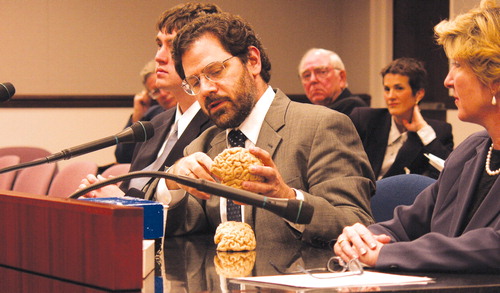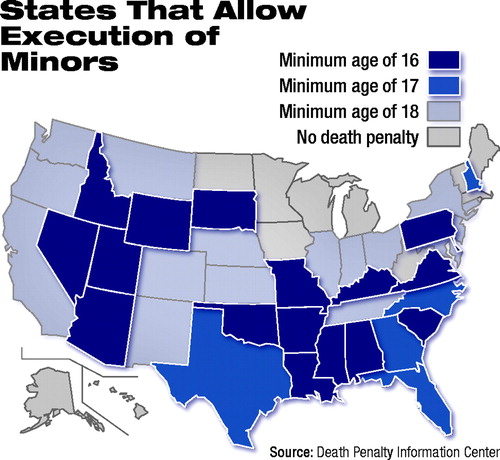Adolescent Brain Development Argues Against Teen Executions
The Nevada State Assembly voted last month to bar executions of criminals who commit crimes before they are 18 years old.
 Passage of the law, which at press time awaits consideration by the Nevada Senate, was aided prominently by APA Trustee-at-Large David Fassler, M.D. During testimony before a state Assembly panel hearing, Fassler told legislators that both APA and the American Academy of Child and Adolescent Psychiatry have “issued strong and unambiguous policy statements opposing juvenile death sentences.”
Passage of the law, which at press time awaits consideration by the Nevada Senate, was aided prominently by APA Trustee-at-Large David Fassler, M.D. During testimony before a state Assembly panel hearing, Fassler told legislators that both APA and the American Academy of Child and Adolescent Psychiatry have “issued strong and unambiguous policy statements opposing juvenile death sentences.”
Fassler, who is also the legislative and public affairs representative for the Vermont Psychiatric Association, provided copies of statements on the issue from both organizations, noting that “neither has a policy pertaining to capital punishment in general, but. . .do have specific positions when the issue involves juvenile offenders.”
Fassler told Psychiatric News that the issue of the execution of juvenile offenders has long concerned him. But he added that preparation for the testimony allowed him the opportunity to review some of the most recent scientific evidence about adolescent brain development and its implications for understanding how teens differ fundamentally from adults in their ability to reason, think, and control impulses.
That evidence appears to have been compelling to lawmakers on the Assembly’s Judiciary Committee, who approved the legislation unanimously and almost immediately following the hearing. The state’s full Assembly approved it 36-6.
In his testimony, Fassler presented a map of the human brain and walked legislators through its anatomy and differential development.
“It’s important to understand that the primitive, or instinctual, part of the brain develops first, followed by the parts of the brain that control reasoning and that help us think before we act,” Fassler told the panel members. “In terms of actual brain anatomy, we’re talking about the amygdala, which is a more primitive part of the brain, responsible for gut reactions, including fear and aggressive behaviors, versus areas like the frontal cortex, which develops later and helps us control our emotions and modify our actions and responses.”
He cited research using functional magnetic resonance imaging demonstrating that teens use their brains differently from adults when reasoning or solving problems. “For example, they tend to rely more on these instinctual structures, like the amygdala, and less on the more advanced areas, like the frontal lobes, which are associated with more goal-oriented and rational thinking.”
As a result, Fassler explained, adolescents are “much more likely to act on impulse, without considering the consequences of their actions, and they are generally more receptive and responsive to intervention and rehabilitation.”
 For these reasons, he urged the Assembly to join states that have already banned executions of adolescents. Currently, 28 states and the federal government ban executions of juveniles who commit a capital offense before the age of 18 (see map).
For these reasons, he urged the Assembly to join states that have already banned executions of adolescents. Currently, 28 states and the federal government ban executions of juveniles who commit a capital offense before the age of 18 (see map).
Attorney Stephen Harper, who is coordinator of the Juvenile Death Penalty Initiative, told Psychiatric News that scientific evidence about adolescent brain development has begun to turn the tide among legislators around the country.
“For the first time, legislators are saying that this issue is not just a matter of law and morality, but of science and adolescent development,” he said.
The Juvenile Death Penalty Initiative is a coalition of organizations, including the American Bar Association, that oppose execution of juvenile offenders.
“We are not saying that offenders under the age of 18 should go free and not be punished,” Harper said. “We are simply saying that given their substantial immaturity, they should not be subject to the ultimate punishment. . . .As to the issue of 18, we draw bright lines all of the time in the law—voting, military service, marriage, contracting, medical decisions.”
Harper noted, “Justice has a sword in one hand and scales in the other. With those scales she balances the nature of the crime with the intent and culpability of the offender. There are some offenders. . .whose acts are so terrible and culpability so great that the death penalty is appropriate. There are some offenders—like the mentally retarded and adolescents—who tip the scales the other way. While their acts may be terrible, their reduced culpability tips the scales the other way.”
Harper also noted that the international legal standard is 18 and that “all countries except the United States and Somalia have ratified the UN Convention on the Rights of the Child, which, among other things, prohibits the death penalty for those who offend while under the age of 18.”
In an interview with Psychiatric News, Fassler said the outcome of the hearing—and his part in it—were gratifying and that the state Assembly’s approval bodes well for the outcome in the state Senate.
“Nevada has a ‘citizen’s legislature,’ very much like Vermont,” he said. “It meets for four months, once every two years; the legislators hold other jobs. The Judiciary Committee included a teacher, an engineer, a firefighter, a cattle rancher, and an obstetrician. As a result, they represented a broad cross-section of views, perspectives, and experience.
“Although in general Nevada is probably viewed as somewhat more conservative than Vermont, the legislative process seemed quite similar and familiar, and the legislators themselves were receptive and responsive,” he said. “They also asked interesting questions about nature versus nurture, prevention and resiliency, and the impact of substance abuse on development and behavior.”
“Talking points” from the Juvenile Death Penalty Initiative and other information pertaining to the execution of juvenile offenders are posted on the Web at www.abanet.org/crimjust/juvjus/resources.html. ▪



